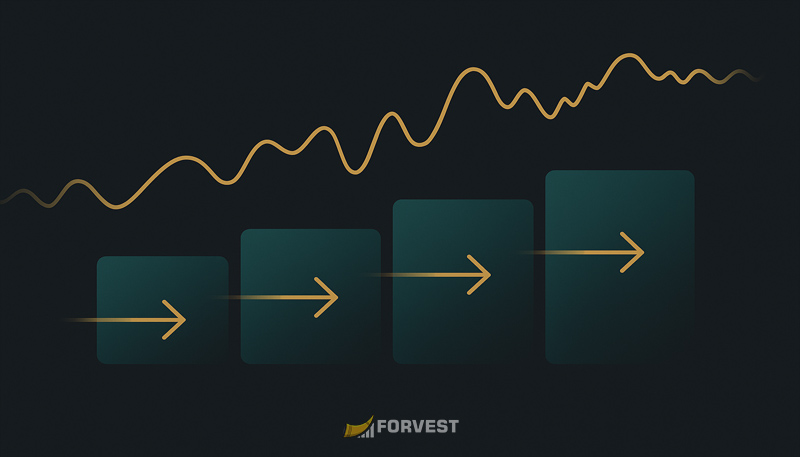Backtest Optimization: Avoid Overfitting & Improve Robustness
A practical guide to stable, out-of-sample results for crypto investors.

- TL;DR
- Why “optimization” often makes backtests worse
- Overfitting in plain English: what it looks like
- The optimization traps unique to crypto
- Split your data the way time works (not randomly)
- Parameter ranges > “magic numbers”
- Walk-forward validation: rolling reality check
- A Practical Robustness Toolkit (what to do after “a good result”)
- Stress tests that matter for investors
- Parameter-Stability Maps (find the plateau, not the spike)
- Regime Robustness (bull, bear, sideways)
- Walk-Forward + Robustness = Deployment Readiness
- A Clean Optimization Workflow You Can Repeat
- Some Notes:
- Conclusion — Stop Optimizing for Yesterday
- Related Forvest Tools in Our AI Assistant, Fortuna
Most backtests don’t fail because the idea is bad—they fail because the optimization was. This guide shows crypto investors how to avoid overfitting with time-based splits, walk-forward validation, and parameter-range thinking so results hold up outside the lab and across changing market regimes.
TL;DR
-
Overfitting = tuning to noise. If tiny tweaks kill results, you never had an edge.
-
Split data chronologically (design vs. out-of-sample), not randomly.
-
Prefer parameter ranges/plateaus over single “magic numbers.”
-
Validate with walk-forward windows (12–18 months) and a full risk panel.
-
Keep fees, slippage, liquidity inside the optimization loop—not bolted on later.

Why “optimization” often makes backtests worse
Optimization should smooth rough edges. In practice it often sculpts a museum-grade equity curve that breaks the moment regimes change. Crypto is ruthless: narratives flip, order books thin, and what worked in 2021 may not survive 2025.
Good optimization clarifies the logic and picks stable settings. Bad optimization hunts the best historical number and calls it “edge.”
Investor mindset: you’re not trying to win last year—you’re trying to survive the next cycle.
Overfitting in plain English: what it looks like
When a strategy only works with one ultra-specific setting, you’re buying noise as if it were signal.
Table 1 — Overfitting symptoms and why investors should care:
| Symptom | What you see | Investor risk |
| Parameter cliffs | One hyper‑specific value required | Fragile in the wild |
| Perfect curve | Suspiciously smooth equity | Likely fit to noise |
| Era dependence | Works in one market phase only | Regime risk later |
| High turnover | Lots of tiny “tweaks” and trades | Fees/slippage will eat returns |
| OOS collapse | Fails right after training (out of sample) | No real edge |
Human test: if you can’t describe the strategy in one sentence, it’s probably over-fitted.
The optimization traps unique to crypto
-
Data snooping: trying many ideas, reporting only winners.
-
Leakage/look-ahead: using information not available at decision time.
-
Survivorship bias: building universes with only coins that survived.
-
Friction blindness: optimizing pre-cost P&L; edge vanishes after fees/slippage.
-
Over-granularity: optimizing daily/hourly while your behavior is monthly (investor vs trader).
-
Regime myopia: training on one mood and mistaking regime effects for skill.
Fixing this isn’t wizardry—it’s process discipline.
Split your data the way time works (not randomly)
Markets are time-dependent. Random K-fold is for i.i.d. data, not portfolios.
Table 2 — Time-based split that matches investor reality:
| Phase | Share of history | Purpose | Rules |
|---|---|---|---|
| Design (In-Sample) | ~60–70% earliest | Build simple, explainable logic | Limit variants; avoid complexity creep |
| Validation (OOS-1) | ~15–20% next | Test only shortlisted variants | No retuning after seeing results |
| Holdout (OOS-2) | ~15–20% last | One-time final exam | Touch once; confirm generalization |
Guidelines:
-
Ensure the full span covers multiple regimes (bull/bear/sideways).
-
Keep cadence investor-appropriate (weekly/monthly), or you’ll optimize execution noise.
-
Evaluate with a panel, not one number: CAGR, Max DD, Sharpe/Calmar, worst year/month, time under water, turnover.
What you want to see: similar character between design and validation, and graceful (not catastrophic) degradation in OOS.

Parameter ranges > “magic numbers”
When you sweep parameters, don’t ask “Where is the peak?” Ask “Where is the plateau?”
-
A plateau is a continuous region with “good-enough” results across many settings.
-
Choose settings inside the plateau, ideally near its center.
-
If you only see sharp spikes, you found noise, not signal.
Investor benefit: plateaus tolerate messy reality—slight data differences, minor delays, or a changing coin mix.

Walk-forward validation: rolling reality check
Static splits can still get lucky. Walk-forward mimics how you’ll actually invest: learn from the recent past, then apply to the next unseen window, and chain results.
How (weekly/monthly cadence):
-
Pick 12–18-month windows; keep tuning modest.
-
Lock parameters (or ranges with a simple selection rule).
-
Run on the next window (true OOS).
-
Roll forward and stitch the equity curve.
Inspect:
-
Rolling Max DD and Sharpe/Calmar—does the personality stay consistent?
-
Time under water per window—does it blow out in some regimes?
-
Turnover vs costs—does it become uneconomic in chop?
Window guidance: too short = you fit noise; too long = you adapt too slowly. 12–18 months is a robust start for investor strategies.
A Practical Robustness Toolkit (what to do after “a good result”)
A pretty equity curve isn’t a green light. Now you try to break your idea on purpose. If it survives, you likely have an edge. If it breaks, you just saved capital.
Stress tests that matter for investors
-
Friction stress: raise fees/slippage by 1.5–2×. A fragile model flips from “great” to “meh.”
-
Data noise: jitter prices ±0.5–1.0% randomly on rebalance days; does the ranking/order flip?
-
Timing drift: shift rebalancing by ±1–2 days (or by clock hour for daily systems).
-
Liquidity realism: remove assets that fall below your minimum volume/cap band in each window.
-
Path dependence: Monte Carlo resample the return path (or day-order) to see outcome dispersion.
-
Bootstrap rebalances: randomly “miss” a fraction of rebalances (e.g., 10%); execution imperfection is real.
-
Regime slices: test subsets: bull-only, bear-only, chop/range. Look for profile consistency.
Investor reading of outcomes: You don’t need identical numbers; you want character stability: same rough drawdown ceiling, similar rolling Sharpe/Calmar, and no sudden “personality swap” (e.g., becoming a momentum chaser in bears).
Parameter-Stability Maps (find the plateau, not the spike)
Sweep your critical knobs (e.g., lookback 90–240, threshold 0.5–1.5σ). Don’t cherry-pick the max; inspect the neighborhood.
What to look for:
-
Plateaus: broad zones where CAGR/Calmar remain acceptable.
-
Graceful edges: performance fades gradually as you move away.
-
No razor peaks: if one hyper-specific combo dominates, assume overfit.
Investor habit: pick parameter ranges you’d be happy to live with (e.g., 120–180 days), then lock a central value (e.g., 150) or a simple selection rule (e.g., choose the median in-range performer).
Regime Robustness (bull, bear, sideways)
Crypto is regime-heavy. Your backtest should read like a character sheet across phases.
-
Bull: Does the model keep up without taking reckless DD?
-
Bear: Does a trend/regime filter meaningfully reduce losses vs buy-and-hold?
-
Sideways: Is turnover costing you? Consider widening bands or slower cadence.
Rule of thumb: If the strategy’s worst phase is catastrophic relative to its peers (or cash), you don’t have an investor model; you have a trade pretending to be one.
Walk-Forward + Robustness = Deployment Readiness
Your “go/no-go” isn’t a single number; it’s a bundle of evidence:
-
Time-based split passed (design → OOS-1 → holdout).
-
Walk-forward curve stitched cleanly with consistent personality.
-
Stress tests didn’t flip the story.
-
Parameters sit in a plateau, not on a cliff.
-
Regime profile is intelligible (you know when it suffers, and how much).

Table 3 — Robustness Stress-Test Checklist
| Category | Test | What you do | What you want to see |
|---|---|---|---|
| Friction | Cost stress | 1.5–2× fees & slippage | Character survives; not a total thesis flip |
| Data | Noise injection | ±0.5–1.0% price jitter on rebalance | Rankings stable; metrics degrade gracefully |
| Timing | Drift test | Shift rebalance by ±1–2 days | No regime personality swap; similar DD ceiling |
| Liquidity | Tradability filter | Enforce min volume/cap per window | Returns stay believable; turnover drops if needed |
| Path | Monte Carlo | Resample day/order; view dispersion | Middle of distribution still investable |
| Execution | Missed actions | Randomly skip ~10% rebalances | No collapse; slightly lower but intact profile |
| Regime | Sliced tests | Bull / bear / sideways subsets | Known weak phase but bounded pain |
Table 4 — Optimization Report Template
| Field | What to record | Example |
|---|---|---|
| Strategy name | One-line description | “EqW BTC/ETH/SOL + 30% cash on risk-off” |
| Objective | What you optimize for | “Sharpe ≥ 1.0; Max DD ≤ 30%” |
| Data span & cadence | Years & frequency | “2019–2025, weekly” |
| Splits | Design / OOS-1 / Holdout | “2019–22 / 2023 / 2024–H1” |
| Friction model | Fees, slippage, spreads | “0.10% fee, 0.05% slip; doubled in stress” |
| Parameter ranges | Swept values | “Lookback 120–180; threshold 0.8–1.2σ” |
| Chosen setting | Inside the plateau? | “150d, 1.0σ (center of plateau)” |
| Core metrics | CAGR / Max DD / Sharpe / Calmar | “19.2% / 28% / 1.14 / 0.69 (holdout)” |
| WF results | Windows & comments | “4×15-mo; stable Sharpe, DD < 30%” |
| Regime profile | Bull / bear / chop | “Bull strong; bear contained; chop manageable” |
| Stress tests | Pass/fail notes | “Cost ×2: still viable; timing ±2d: OK” |
| Risks & limits | Where it breaks | “High-fee venues; thin coins; deep chop at high turnover” |
| Next actions | What to improve | “Wider bands in chop; cap SOL at 40%” |
| Decision | Ship / Iterate / Drop | “Ship small; monitor turnover & DD alerts” |
A Clean Optimization Workflow You Can Repeat
-
Frame the goal (risk/return). If you can’t state it in one sentence, stop.
-
Time-based split (design → validation → holdout).
-
Friction-in-the-loop (fees, slippage, liquidity) from day one.
-
Parameter sweep → plateau selection (not spike-hunting).
-
Walk-forward (12–18-month steps), inspect rolling risk metrics.
-
Robustness battery (cost stress, noise, timing, liquidity, path, missed actions, regime slices).
-
Optimization report (Table 2), commit the evidence.
-
Paper / tiny-live with alerts; review vs. backtest expectations.
-
Scale prudently only after consistency shows up out of sample.
Some Notes:
If you can’t sleep with the worst-case drawdown, the model will fail—you will deviate first.
A slightly worse CAGR with a saner Max DD often wins the long game.
When in doubt, blend two robust but different characters (e.g., EqW+regime with a light momentum tilt), then re-test as one policy.
Conclusion — Stop Optimizing for Yesterday
Robust optimization isn’t about beating a backtest—it’s about building a portfolio policy that survives fees, noise, timing, and mood swings. Choose plateaus, respect time, and try to break your own idea. If it still stands, then—and only then—press “go.”
Related Forvest Tools in Our AI Assistant, Fortuna
Forvest Trust Score helps investors evaluate crypto projects based on real transparency and reliability metrics. It identifies trustworthy assets and highlights hidden risks, guiding you toward safer investment decisions.
Forvest Alerts keeps you informed about key market movements and sentiment shifts — not just prices, but also major news that may impact your portfolio — helping you stay proactive instead of reactive.
— Forvest Research
FAQs
Overfitting happens when a strategy is tuned to past noise, not true signal—tiny parameter changes break performance out of sample.
Use chronological splits: design (in-sample), validation (OOS-1), and a final holdout (OOS-2). Never tune after seeing OOS results.
Walk-forward tunes on a recent window, tests on the next unseen window, and stitches results—mimicking real deployment and exposing fragile settings.
No—choose a parameter plateau (a range with consistently good results). Plateaus tolerate data quirks, timing drift, and execution noise.
Model fees and slippage inside the optimization loop (and stress them ×1.5–2). Many “edges” vanish once frictions are honest.
Slice results by bull, bear, and sideways periods. You want consistent character and bounded drawdowns, not one-era heroics.
Cost stress, data noise, timing drift (±1–2 days), liquidity filters, Monte Carlo path resampling, and missed-rebalance simulations.







